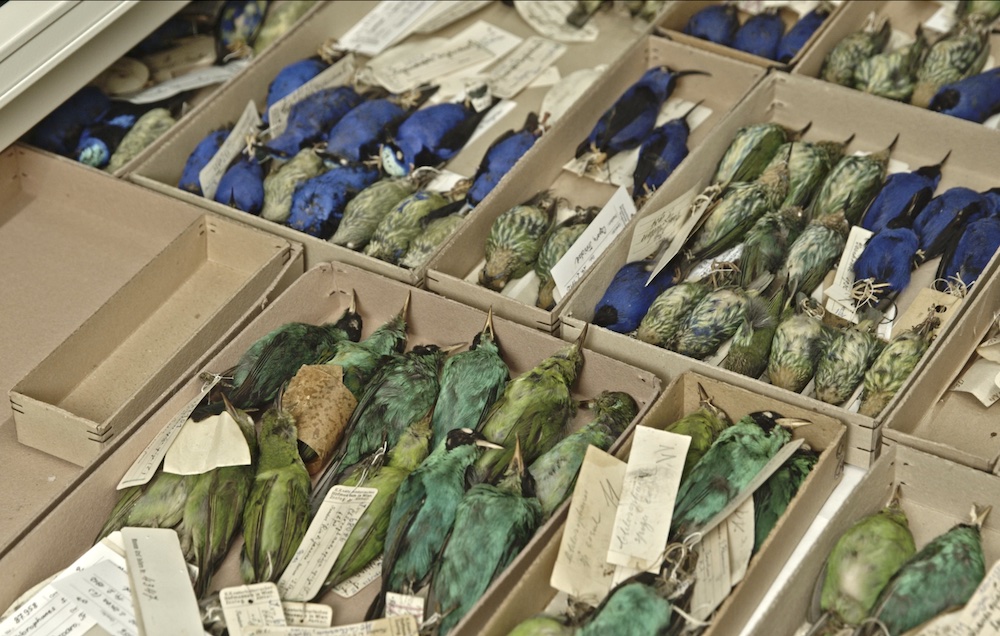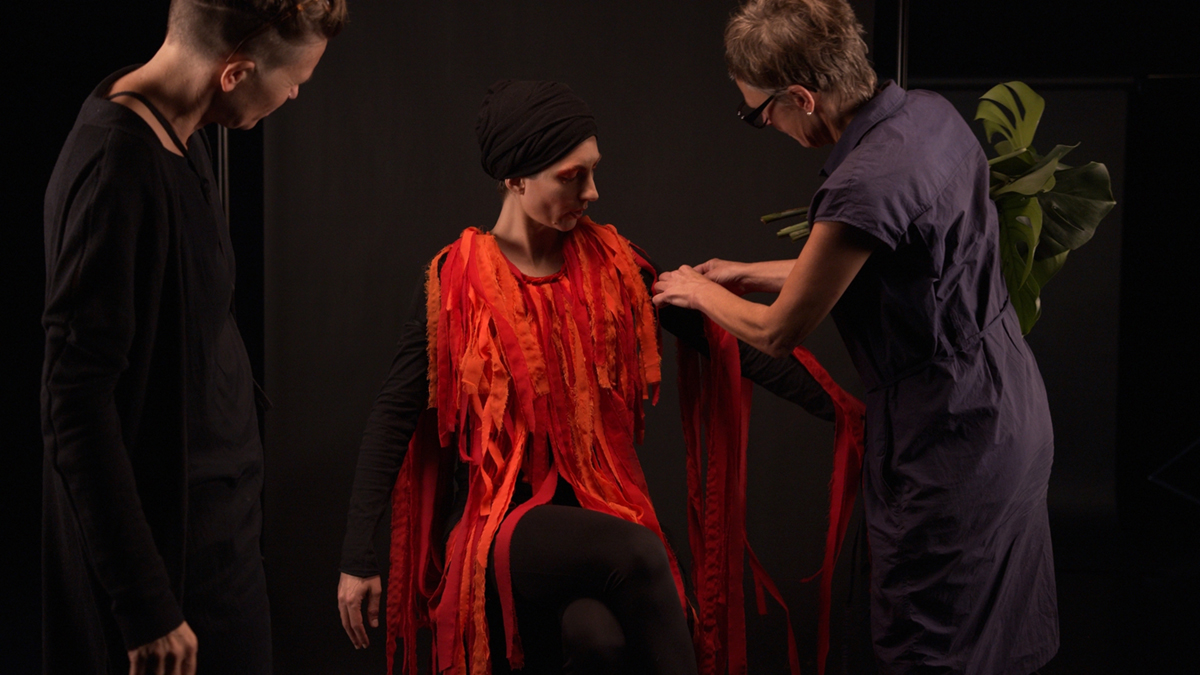re-BIRDING
2023 / video / 6K / 16:9 / colour / sound / 26 min
As in most of my works, I deal with marginalised groups and their absence in the established historiography and take a critical look at intentionally misconstructed narratives of the legacies of our ancestors. re-BIRDING examines the ecological and economic interrelationships and impacts with regard to the ongoing extinction of species and the dwindling biodiversity on earth. In the film I examine ecological and economic connections and effects in connection with the ongoing extinction of species. In doing so, I poetically link human voice production with that of selected endangered or already extinct bird species. The film sheds light on the current situation of songbirds in Europe in particular as well as on irretrievable colonial damage. Based on studies conducted by (transdisciplinary) research projects and bird stations and Red Bird Index lists, representatives of various endangered or already extinct bird species get a voice and reflect on current society, its ecological and economic structures as well as their view of the environment, and ask how far human treatment of nature affects biodiversity and ultimately us humans again.
In the film, I reflect on colonial and ecological violence and alternative collective activities of reparation, recovery and restoration in terms of a more sustainable and harmonious relationship with the surroundings, the environment, the land.
Background
Birds are indicators: their population changes provide information about the state of landscapes and natural areas. Like many other creatures, they are essential for life on earth. Considering the planned and partially already realised deforestation of various forests, the largest of which is certainly the Amazon rainforest, we need to rethink and develop and disseminate strategies to protect the earth from multiple abuses. In Europe, too, the number of birds has dropped drastically. Bird species that live in agricultural landscapes are particularly affected. The change in food production due to industrially organised agriculture, hunting, the lack of suitable habitats and food, water pollution, deforestation, radio towers, sealing and climate change are responsible for the progressive bird mortality and the reduction of existing populations, especially of bird species living in meadows.
The landscape of endangered species includes not only birds but also plant species, yet I refer exclusively to bird species due to my interest in the voice (of humans and birds), its production, functions and possibilities.
A charming side-effect of the inherent territoriality of birds, their mere manifestation, is that, with their song, they are able to enrich the environment. Of course, the current situation of many bird species is anything but enchanting and needs to be disenchanted in a technical sense in order to develop and implement strategies to counteract the extinction of birds and species.
The film also reflects on the historical course, on historicity and narrativity: the definitive, the completed, which can no longer be intervened in; the present, the expected extinction of species, above all through human influence, and finally the coming, which still can be changed.

In terms of time, the film concentrates on the "modern" situation of bird species that became extinct worldwide after 1500. In the middle of the 16th century, European countries started to explore the so-called New World and began to colonise even the most remote regions of the world. They exploited the new land which, among other severe damages, resulted in the extinction of endemic animals, among them numerous bird species. Scientifically substantiated study results state that today about 12% of all bird species are acutely threatened with extinction and another 12% are considered endangered.
As far as the region is concerned, I limit my research to Europe, where the conditions of bird species are relatively similar, and assemble a selection of recently extinct bird species. The reason for the extinction of those bird species is clearly due to alien species or hunting (for food or for their plumage). In my film some bird figures are not assigned to this region, but interesting because of certain aspects: their significant appearance, their idiosyncratic way of life or their particularly tragic fate. Especially in colonised regions, bird species were rapidly exterminated. Thus, dozens of bird species have become extinct since or with the arrival of humans on the Pacific islands — some already since the settlement by the Polynesian population about 1000 years ago, most finally with the beginning of European expeditions and land grabbing. Probably about 30-50 of the endemic species are extinct today.
The damage done by European states in their former colonies must be clearly addressed here. But the damage is not only in these distant ex-colonies, but also in our immediate surroundings; in the (Central) European cultivated landscapes already a large number of endangered bird species is reported.
How does our present Western society relate to the historical treatment of bird populations? How do historical economic and ideological infrastructures reverberate today? What about contemporary rural capitalism, the right to kill or the question of ownership? How are property relations constructed today? For this purpose, I shed light on the current situation of bird species in Europe. What dangers and threats are they facing today? How can the progressive bird mortality be prevented or at least slowed down? What strategies can we develop or apply to protect birds (and of course other species)?
My concept mainly feeds on Donna Haraway’s critique of anthropocentrism and her concept of collectivation, composting and composing, developing social constructions, techno-sciences and emancipatory ideas against capitalist economies and structures by creating string figures and taking a speculative feminist stance; to Bruno Latour’s critique of our society’s modern conception of nature and culture, to Lynn Margulis and James Lovelock as well as to Vincianne Despret, who speaks of the Phonocene, meaning the age of the sound-producing world. These theoretical aspects are translated into a poetic language that not only looks back at the cultural history of our society, but also articulates strategies on how to slow down or stop the decline of bird populations.
The bird figures are emblematic of all species that have been persecuted, displaced, destroyed and exterminated, be they indigenous peoples displaced by colonialists, be they so-called marginalised groups that have no voice and/or are oppressed, be they non-human organisations that fall or fell victim to capitalist and neoliberal strategies.
Tracing a world without recording systems
The musical layer of the film is as important as the visual layer. Birds use the same mechanism to produce their voices as humans do. While humans produce sounds in the larynx, most birds produce their sounds in the syrinx, named after the Greek panpipe, the forerunner of the contemporary flute. In the late 18th and early 19th centuries, small flutes such as the flageolet were used to teach birds in cages to sing popular melodies in order to increase their market value.
The birds’ lost sounds, essential tools of communication and territorial manifestation, are (re)constructed or invented anew by the use of artificial, instrumental sound. What might an extinct bird have sounded like? (How) can a song be translated into a contemporary, artificial sound? Varying translations of bird sounds are developed from collected natural sounds (field recordings) and the development of artificial sound material (compositions). In these composition of pieces for voices and instruments, I refer to tradition, records and interviews as well as to poetic-technical translations of archived bird recordings, revisiting musical sources, historical as well as contemporary.
All collected and generated sound material is instrumented by voices, recorders, transverse flutes, electronics, synthesizers, etc. Especially the use of transverse flutes, and here specifically the recorder is obvious, since recorder derives from Latin: recordārī – to remember, recall, memorise, repeat, recite, make music, from French: recordeur – someone who retells.
All sounds are simulations, invented sound objects, poetic approximations of the unrecorded sounds of the past.
By reconstructing and reanimating the blank spaces, lost or unknown information of the disappeared, the non-real, the no longer existing is emphasised even more – the sonic act as becoming world (again). Here, the vocal act will not only be reproduction or invention of sounds but also an expression of artistic and collective thinking.
Cybirds?
Birds have to defend themselves against (especially urban) man-made noise or develop strategies to be able to communicate and ultimately survive. Do such strategies turn birds into cybirds?

Cast:
Birds: Aurelia Burckhardt, Christine Gnigler, Juli Müllner, Maja Osojnik, Karolina Preuschl
Narrating voice: Anat Stainberg
Angel of History/questioning voice: Elisa Martinot
Concept, edit, colour grading: Michaela Schwentner
Camera: Martin Putz, Michaela Schwentner
Music & Sound design: Maja Osojnik
Choir: Christine Gnigler, Maja Osojnik, Karolina Preuschl, Sara Zlanabitnig
Flute players: Christine Gnigler, Maja Osojnik, Sara Zlanabitnig
Recordings, mix & mastering: Nik Hummer
Set design: Michaela Schwentner
Costume design: Julia Cepp, Michaela Schwentner
Make up: Miyu Haydn
Assistance: Nik Thoenen
Supported by BMKOES and Stadt Wien Kultur
Birds: Aurelia Burckhardt, Christine Gnigler, Juli Müllner, Maja Osojnik, Karolina Preuschl
Narrating voice: Anat Stainberg
Angel of History/questioning voice: Elisa Martinot
Concept, edit, colour grading: Michaela Schwentner
Camera: Martin Putz, Michaela Schwentner
Music & Sound design: Maja Osojnik
Choir: Christine Gnigler, Maja Osojnik, Karolina Preuschl, Sara Zlanabitnig
Flute players: Christine Gnigler, Maja Osojnik, Sara Zlanabitnig
Recordings, mix & mastering: Nik Hummer
Set design: Michaela Schwentner
Costume design: Julia Cepp, Michaela Schwentner
Make up: Miyu Haydn
Assistance: Nik Thoenen
Supported by BMKOES and Stadt Wien Kultur